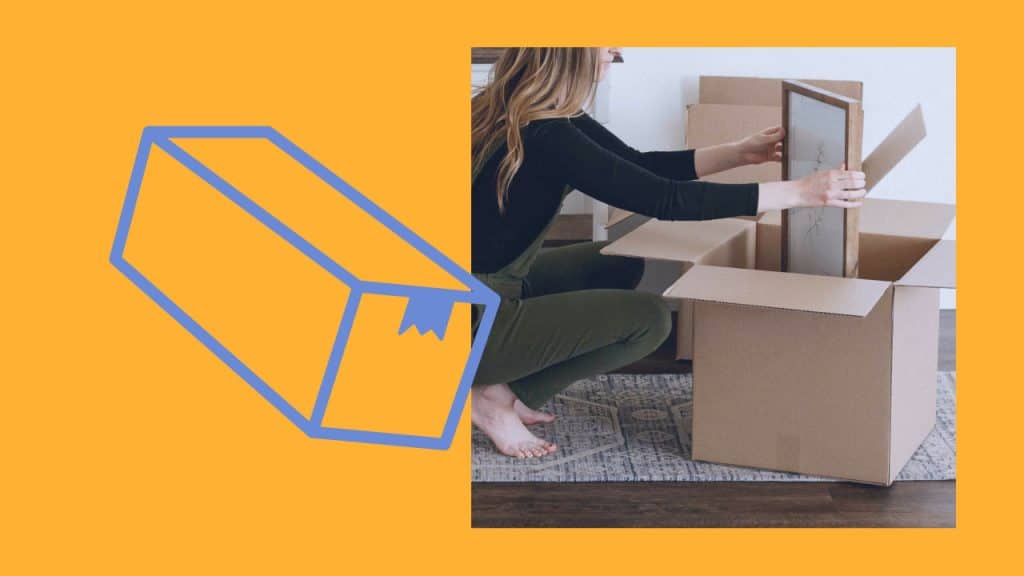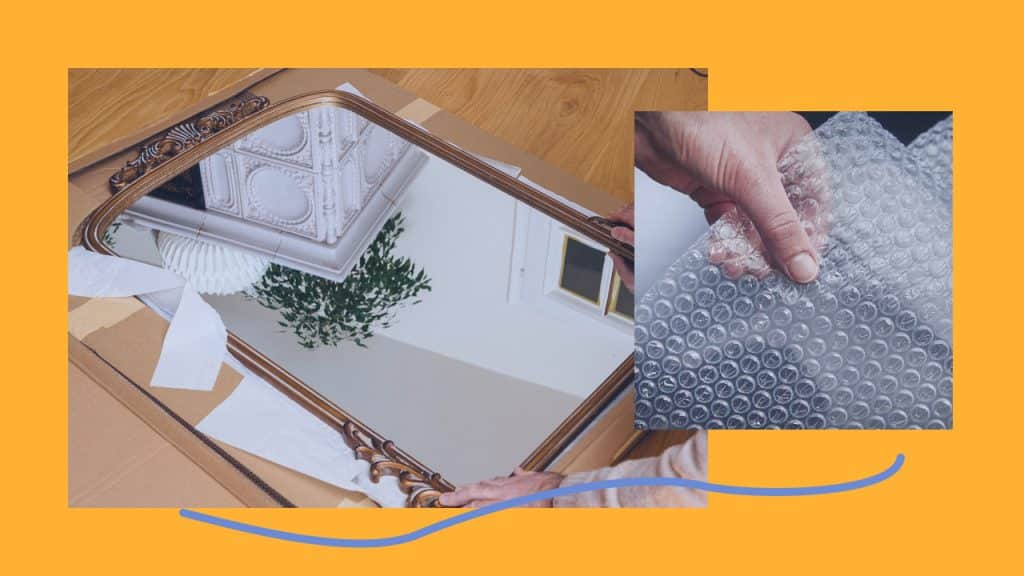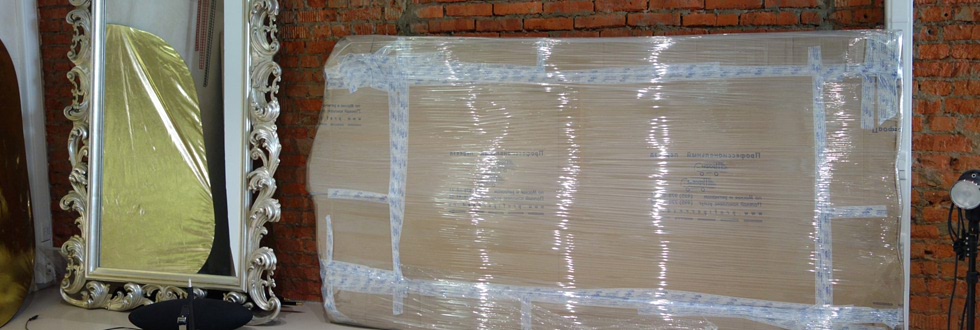Moving mirrors is no easy feat. Not only are they heavy and large, but they are also incredibly fragile. The risk of damage is high, not only to the mirror, but to you as well. Therefore, we ask you to be extremely careful! In this guide on how to pack mirrors for moving, we’ll walk you through the basic steps of packing and moving any mirror, whether it’s a heavy wall piece or a frameless mirror. AOA Moving Services want to make sure not only your mirror stays safe, but you too!
Preparation: Supplies You Need
Before you start, ensure you have all the necessary supplies. Here’s what you’ll need along with recommendations on where to find them:
| Packing Material | Purpose | Where to Get It |
| Mirror Boxes | Adjustable to fit mirrors snugly, providing protection. | Moving companies, Home Depot, Lowe’s, Amazon, Walmart |
| Packing Tape | Secures the mirror box and protective wrapping. | Moving companies, Home Depot, Amazon, Walmart |
| Bubble Wrap | Cushions and protects the mirror’s surface and edges from impacts. | Moving companies, Staples, Amazon, Walmart |
| Painter’s Tape | Helps keep the glass intact if it cracks, preventing shattering. | Art supply stores, Home Depot, Lowe’s, Amazon |
| Cardboard Pieces | Offers additional protection, especially for edges or as an extra layer. | Moving companies, recycling centers, Home Depot, U-Haul |
| Packing Paper | Provides a scratch-free layer to protect the mirror’s surface. | Moving companies, Staples, U-Haul, Amazon |
Step-by-Step Guide for Packing Mirrors for Moving
1. Protecting the Mirror Surface
Before proceeding directly to packing, we need to ensure the integrity of the mirror surface, also for safety reasons.
Materials Needed:
- Painter’s tape
Instructions:
- For All Mirrors: The first thing we’ll do is put the painter’s tape on the surface of the mirror in the shape of a large “X”. This will help hold the mirror in place. And, in the event that the mirror cracks, it will break into smaller pieces.
- For Frameless and Decorative Mirrors: Here you should add a mesh of tape over the entire surface to provide additional stability and protection.

2. Creating a Custom Mirror Box
The mirrors are unique and varied. The most reliable way and not to use a ready-made box, but to create your own. It is not difficult at all.
Materials Needed:
- Measuring tape
- 4 large, flat cardboard pieces
- Packing tape
Instructions:
- Measure Your Mirror: First, we have to keep in mind that we need to add about 4 inches to the size of each mirror to leave room for padding.
- Construct the Box: We take two pieces of cardboard and make the front and back of the box, cutting them to the size of the mirror. The remaining two pieces we use for the sides. We cut them according to the depth of the mirror. Don’t forget about the extra space.
- Secure the Edges: Next, we carefully glue all the edges and corners. We should have a sturdy box! If the mirror is very large, we should reinforce the corners with additional cardboard for more strength.

💡 If you are moving with pros, then do not forget to indicate on the box: “Fragile” and “This side up” to ensure careful handling.
3. Wrapping Techniques for Protection
Materials Needed:
- Bubble wrap
- Packing paper
Instructions:
- Layer of Packing Paper: Next we move on to the mirror itself. We wrap the mirror with packing paper, securing it with tape. The paper should cover the mirror completely!
- Bubble Wrap: Next, we wrap the mirror in bubble wrap on top of the paper layer. We also cover the mirror completely.

4. Corner and Edge Protection
Materials Needed:
- Cardboard
- Bubble wrap or foam padding
Instructions:
- For Frameless Mirrors: Cut small pieces of cardboard to fit each corner of the mirror. We then secure these cardboard protectors with tape.
- Wrap Edges: For additional protection, we wrap the edges of the mirror with foam or bubble wrap. Secure with tape.

That’s it! We place our packed and protected mirror in the box!
Moving the Mirror: Best Practices
We packed the mirror. However, that’s only half the journey. Now we proceed to safe shipment!
Tools and Materials:
- Sturdy dolly or hand loader
- Straps or rope to secure the mirror
- Gloves for a better grip
Instructions:
- Secure the Mirror: We place our packed mirror vertically on the cart. We then secure it with straps or rope. This will prevent the mirror from tipping or falling over.
💡 Small Tips Gloves are important, because it will be better to "grip" and the mirror will not jump out of your hands. I also advise you to bend at the knees when lifting the mirror, and not at the waist, so as to strain your back less. And, of course, take your time. We transfer everything carefully and slowly.
❗ Keeping the Mirror Upright Why Not Flat? The mirror should not be transported flat. This greatly increases the risk of it breaking. Any pressure on the surface of the mirror will cause it to crack or shatter.
- Best Practices:
- Always Transport Upright: Try to moving the mirror in an upright position. Even if we are talking about personal transportation. If possible, try to position it vertically. Use straps or rope to secure it to a stable surface, such as the side of a truck or between heavy pieces of furniture that will not move.
- Avoid Pressure: Ideally, nothing should be pressed directly against the surface of the mirror. Otherwise, we should use soft objects (blankets or pillows) as a buffer between the mirror and other objects.
Special Considerations
Below we look at some of the special points to consider when transporting mirror.
Moving Mirrors in Adverse Weather Conditions
Weather Challenges:
- Rain and Moisture: Water can damage both the mirror’s frame and its reflective backing.
- Extreme Temperatures: Both hot and cold extremes can cause the mirror to expand or contract, potentially leading to cracks.
Prevention Tips:
- Wrap in Plastic: In addition to the bubble wrap, we should wrap the mirror with a layer of plastic wrap to protect it from moisture.
- Climate Control: If possible, we should transport the mirror in a climate-controlled vehicle to avoid temperature extremes. Moving trucks are usually ready for temperature changes.
Navigating Tight Spaces
Challenges:
- Narrow Doorways and Hallways: These can make maneuvering large mirrors difficult and increase the risk of bumps or drops.
Strategies:
- Measure in Advance: We should measure the dimensions of the mirror and the spaces we will have to move through in advance. If possible, remove obstacles in advance.
- Use Helpers: If available, have someone guide you through tight spots, watching for potential hazards and advising on angles and positioning.
FAQs Section
Why must mirrors be transported upright?
Transporting upright prevents undue stress on the glass, reducing the risk of cracks or breakage.
How should I handle frameless mirrors?
Wrap edges in protective materials like bubble wrap and handle carefully to avoid pressure on the glass.
What’s the best way to move a heavy mirror by myself?
Use a dolly for support, secure the mirror with straps, and ensure clear, obstacle-free paths.
Conclusion
We’ve shown you how to pack mirrors for moving and the best practices for transporting them safely.
For those who need professional help, AOA Moving Services specializes in packing and moving delicate items such as mirrors. Explore our professional packing service for more information. Contact us if you want to get answers to your questions, the consultation is free!
